 | | | Switch to: Europe, USA, New Zealand, Antarctica Credit: NOAA/Ovation  Planetary K-index Planetary K-index
Now: Kp= 1 quiet
24-hr max: Kp= 6 storm
explanation | more data
Interplanetary Mag. Field
Btotal: 11.3 nT
Bz: 3.4 nT north
more data: ACE, DSCOVR
Updated: Today at 2346 UT  Coronal Holes: 14 Mar 22 Coronal Holes: 14 Mar 22 
There are no significant coronal holes on the Earthside of the sun. Credit: SDO/AIA  Noctilucent Clouds Noctilucent Clouds
The southern season for noctilucent clouds is over. It ended on Feb. 20, 2022, concluding the weakest NLC season in 14 years. The northern season will begin in late May.. Switch view: Ross Ice Shelf, Antarctic Peninsula, East Antarctica, Polar Updated at:  SPACE WEATHER
NOAA Forecasts | | Updated at: 2022 Mar 14 2200 UTC FLARE | 0-24 hr | 24-48 hr | CLASS M | 25 % | 25 % | CLASS X | 05 % | 05 % |  Geomagnetic Storms: Geomagnetic Storms:
Probabilities for significant disturbances in Earth's magnetic field are given for three activity levels: active, minor storm, severe storm Updated at: 2022 Mar 14 2200 UTC Mid-latitudes | 0-24 hr | 24-48 hr | ACTIVE | 40 % | 25 % | MINOR | 25 % | 05 % | SEVERE | 05 % | 01 % | High latitudes | 0-24 hr | 24-48 hr | ACTIVE | 10 % | 15 % | MINOR | 20 % | 30 % | SEVERE | 65 % | 30 % | | | |  | | | | | | | | | | | Lights Over Lapland has a full catalogue of exciting adventures in Abisko National Park, Sweden! Check out our daytime and evening activities and book your adventure! | | | EARTH DIRECTED SOLAR FLARE: Sprawling sunspot AR2965 exploded today, March 14th (0840 UT), producing an M2-class solar flare: movie. The Earth-directed flare caused a minor shortwave radio blackout over Africa and eastern Europe; frequencies affected were mostly below 15 MHz. First look data suggest that the flare did not produce a significant CME. Stay tuned for updates. Solar flare alerts: SMS Text. CME IMPACT SPARKS BRIGHT AURORAS: As predicted, a CME hit Earth's magnetic field on March 13th. The impact sparked a moderately strong G2-class geomagnetic storm, which lasted more than 12 hours. "It was the best Northern Lights show for years," reports Jónína Óskarsdóttir, who sends this picture from Fáskrúðsfjörður, Iceland: 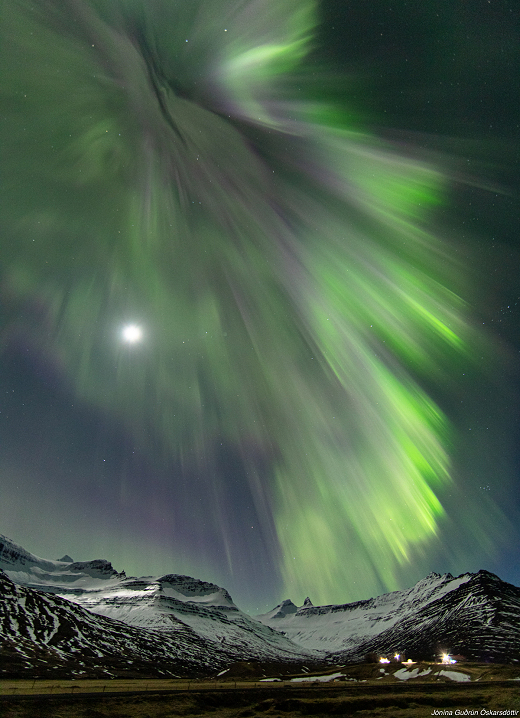
Other observers echoed Óskarsdóttir. "Best display I've seen in years," says Alan C. Tough of Moray, Scotland. "Brightest aurora in 7 years," reports Laura Kranich of Kiel, Germany. "This was the best I've seen here in the south of Norway," says Liz Gyurgyak. In addition to auroras, the CME also jolted Earth's magnetic field and caused electricity to flow through the soil of northern Norway. Citizen scientist Rob Stammes measured these effects from his space weather observatory in the Lofoten islands. The whole episode is a sign of strength from young Solar Cycle 25--and a hint of things to come. If forecasters are correct, Solar Max will arrive in 2 to 3 years bringing even stronger storms. If you haven't seen auroras yet, you might soon. Aurora alerts: SMS Text. more images: from Minoru Yoneto of Queenstown, New Zealand; from Piotr Wieczorek of Pieczyska, Poland; from Markus Varik of Tromsø, Norway; from Paul Clements of Kirtomy, UK; from Petr Horálek of Ústupky, Czech Republic; from Gary King of Chesterfield, New Hampshire; from Stephane of Copenhagen, Denmark; from Pentti Arpalahti of Helsinki, Finland; from Heiko Ulbricht of Herzogswalde, Saxony, Germany; from Raimondas Ciuplys of Trakai, Lithuania; Realtime Aurora Photo Gallery
Free: Spaceweather.com Newsletter
STERLING SILVER OPAL PENDANT: It's our most beautiful space pendant ever: The Sterling Silver Opal. The students of Earth to Sky Calculus launched this one to the stratosphere onboard a cosmic ray research balloon: 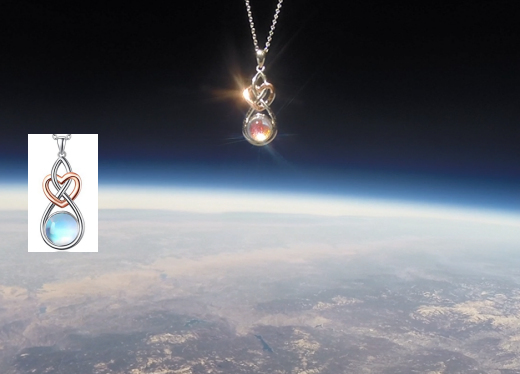
You can have it for $179.95. Wrapped in a sterling silver Celtic love knot, the opal is suspended from a matching 18-inch chain. Each pendant comes with a greeting card showing the opal in flight, telling the story of its trip to the edge of space and back again. Opals are cousins of moonstones; in fact they look the same in low light. But when bright sunlight strikes an opal, something special happens. A spray of color emerges from the stone. This happened while the stone was in the stratosphere (see above) and it remains capable of this beautiful trick back on Earth. Far Out Gifts: Earth to Sky Store
All sales support hands-on STEM education
Realtime Space Weather Photo Gallery
Free: Spaceweather.com Newsletter Every night, a network of NASA all-sky cameras scans the skies above the United States for meteoritic fireballs. Automated software maintained by NASA's Meteoroid Environment Office calculates their orbits, velocity, penetration depth in Earth's atmosphere and many other characteristics. Daily results are presented here on Spaceweather.com. On Mar 14, 2022, the network reported 4 fireballs.
(4 sporadics) 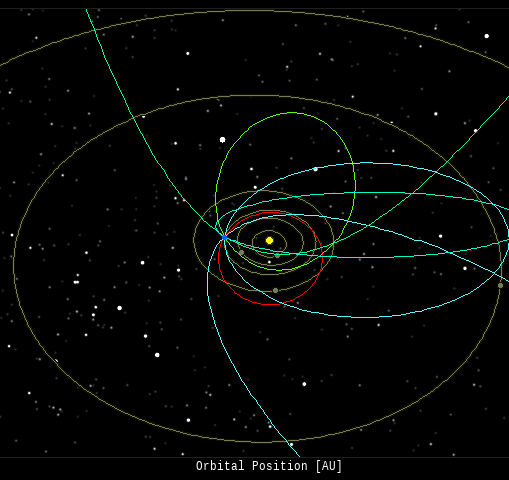 In this diagram of the inner solar system, all of the fireball orbits intersect at a single point--Earth. The orbits are color-coded by velocity, from slow (red) to fast (blue). [Larger image] [movies] Potentially Hazardous Asteroids ( PHAs) are space rocks larger than approximately 100m that can come closer to Earth than 0.05 AU. None of the known PHAs is on a collision course with our planet, although astronomers are finding new ones all the time. On March 14, 2022 there were 2271 potentially hazardous asteroids.
 | Recent & Upcoming Earth-asteroid encounters: | Asteroid | Date(UT) | Miss Distance | Velocity (km/s) | Diameter (m) | | 2022 DS3 | 2022-Mar-09 | 13.4 LD | 3.7 | 15 | | 2022 EM4 | 2022-Mar-09 | 7.7 LD | 6.8 | 29 | | 2022 EV3 | 2022-Mar-09 | 0.2 LD | 10.5 | 4 | | 2022 EC2 | 2022-Mar-09 | 10.8 LD | 12.3 | 15 | | 2022 EN3 | 2022-Mar-10 | 7.6 LD | 17.6 | 32 | | 2022 EV4 | 2022-Mar-10 | 14.2 LD | 7.1 | 16 | | 2021 EY1 | 2022-Mar-10 | 10.1 LD | 15.5 | 16 | | 2015 DR215 | 2022-Mar-11 | 17.5 LD | 8.3 | 290 | | 2022 EV1 | 2022-Mar-11 | 10.7 LD | 8.3 | 22 | | 2009 DV43 | 2022-Mar-11 | 8.2 LD | 16.5 | 65 | | 2022 DX2 | 2022-Mar-13 | 15.7 LD | 12.7 | 35 | | 2022 DR3 | 2022-Mar-13 | 15.7 LD | 12.4 | 32 | | 2018 GY | 2022-Mar-13 | 11.9 LD | 10.7 | 43 | | 2022 BX1 | 2022-Mar-13 | 20.1 LD | 11 | 161 | | 2022 ES3 | 2022-Mar-13 | 0.9 LD | 18.3 | 13 | | 2022 EO4 | 2022-Mar-13 | 2.8 LD | 15.6 | 30 | | 2022 EA1 | 2022-Mar-14 | 8.1 LD | 5.5 | 13 | | 2022 EC6 | 2022-Mar-14 | 8.4 LD | 7.2 | 14 | | 2022 EK4 | 2022-Mar-14 | 4.8 LD | 8.3 | 19 | | 2022 ED4 | 2022-Mar-15 | 2.1 LD | 17 | 17 | | 2022 DP3 | 2022-Mar-15 | 3 LD | 10.8 | 41 | | 2022 EG3 | 2022-Mar-15 | 13.7 LD | 6.5 | 8 | | 2022 EF4 | 2022-Mar-16 | 6.9 LD | 12.1 | 25 | | 2019 PH1 | 2022-Mar-17 | 12.3 LD | 15.9 | 37 | | 2022 EU3 | 2022-Mar-17 | 14.2 LD | 5 | 14 | | 2022 DB2 | 2022-Mar-18 | 11 LD | 8.6 | 52 | | 2016 FZ12 | 2022-Mar-19 | 2.2 LD | 8.3 | 16 | | 2022 DX | 2022-Mar-19 | 8.5 LD | 1.5 | 8 | | 2022 ER5 | 2022-Mar-20 | 2.1 LD | 12.3 | 27 | | 2022 EE4 | 2022-Mar-21 | 18 LD | 16.9 | 33 | | 2022 DG3 | 2022-Mar-21 | 18.3 LD | 7.2 | 37 | | 2020 SQ | 2022-Mar-21 | 2.8 LD | 6 | 12 | | 2022 EA5 | 2022-Mar-23 | 14.9 LD | 8 | 19 | | 2013 BO76 | 2022-Mar-24 | 13.3 LD | 13.8 | 271 | | 2011 GE3 | 2022-Mar-26 | 7.6 LD | 7 | 22 | | 2012 FX35 | 2022-Mar-26 | 13.7 LD | 5.9 | 25 | | 2022 EL5 | 2022-Mar-29 | 7.1 LD | 3 | 12 | | 2010 GD35 | 2022-Mar-29 | 17.7 LD | 12.5 | 43 | | 2020 FW5 | 2022-Mar-30 | 8.9 LD | 13.1 | 27 | | 2022 EK1 | 2022-Mar-30 | 19 LD | 7.6 | 44 | | 2022 DX4 | 2022-Mar-31 | 16.7 LD | 6 | 40 | | 2007 FF1 | 2022-Apr-01 | 19.4 LD | 12.8 | 155 | | 2021 GN1 | 2022-Apr-02 | 14.4 LD | 14.3 | 19 | | 2016 GW221 | 2022-Apr-02 | 9.8 LD | 5.9 | 41 | | 2022 EN2 | 2022-Apr-04 | 18.7 LD | 5.6 | 41 | | 2012 TV | 2022-Apr-05 | 19.2 LD | 18.1 | 32 | | 2020 GH1 | 2022-Apr-09 | 16.8 LD | 7.2 | 28 | | 2017 TO2 | 2022-Apr-10 | 17.9 LD | 11.6 | 78 | | 363599 | 2022-Apr-12 | 19.3 LD | 24.5 | 221 | | 2020 TQ6 | 2022-Apr-18 | 13.4 LD | 15.4 | 43 | | 2017 UR2 | 2022-Apr-22 | 19.4 LD | 9.3 | 10 | | 2020 VN1 | 2022-Apr-25 | 19.3 LD | 2.3 | 9 | | 418135 | 2022-Apr-28 | 8.5 LD | 10.4 | 443 | | 2017 XO2 | 2022-May-01 | 18.8 LD | 12.4 | 118 | | 2017 HG1 | 2022-May-04 | 18.2 LD | 6 | 11 | | 467460 | 2022-May-09 | 14.9 LD | 11.3 | 513 | | 2019 JE | 2022-May-11 | 4.9 LD | 7.2 | 20 | Notes: LD means "Lunar Distance." 1 LD = 384,401 km, the distance between Earth and the Moon. 1 LD also equals 0.00256 AU. MAG is the visual magnitude of the asteroid on the date of closest approach. | | Cosmic Rays in the Atmosphere | SPACE WEATHER BALLOON DATA: Almost once a week, Spaceweather.com and the students of Earth to Sky Calculus fly space weather balloons to the stratosphere over California. These balloons are equipped with sensors that detect secondary cosmic rays, a form of radiation from space that can penetrate all the way down to Earth's surface. Our monitoring program has been underway without interruption for 7 years, resulting in a unique dataset of in situ atmospheric measurements. Latest results (Nov. 2021): Our balloons have just measured a sudden drop in atmospheric radiation. It happened during the strong geomagnetic storms of Nov. 3-4, 2021. Here are the data: 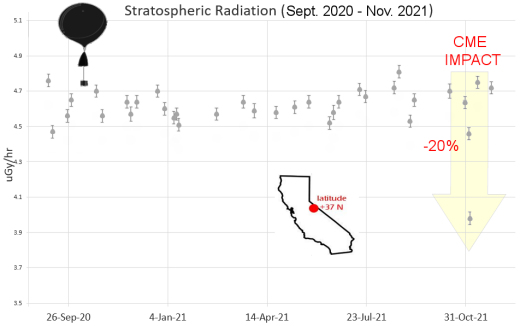
This is called a "Forbush decrease," named after American physicist Scott Forbush who studied cosmic rays in the early 20th century. It happens when a CME from the sun sweeps past Earth and literally pushes cosmic rays away from our planet. Radiation from deep space that would normally pepper Earth's upper atmosphere is briefly wiped out. We have measured Forbush decreases before. For example, here's one from Sept. 2014. The Forbush Decrease of Nov. 3-4, 2021, was the deepest in the history of our 7-year atmospheric monitoring program. Radiation levels in the stratosphere over California dropped nearly 20%, more than doubling the previous record from our dataset. En route to the stratosphere, our sensors also pass through aviation altitudes, so we can sample radiation where planes fly. This plot shows how the Forbush decrease was restricted to the stratosphere; it did not affect lower levels of the atmosphere: 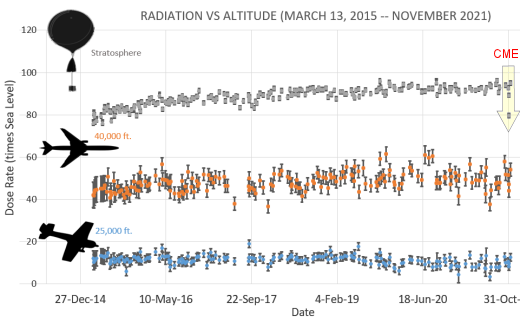
The dose rates shown above are expressed as multiples of sea level. For instance, we see that boarding a plane that flies at 25,000 feet exposes passengers to dose rates ~10x higher than sea level. At 40,000 feet, the multiplier is closer to 50x. The higher you fly, the more radiation you will absorb. .Who cares? Cosmic rays are a surprisingly "down to Earth" form of space weather. They can seed clouds, trigger lightning, and penetrate commercial airplanes. According to a study from the Harvard T.H. Chan school of public health, crews of aircraft have higher rates of cancer than the general population. The researchers listed cosmic rays, irregular sleep habits, and chemical contaminants as leading risk factors. Somewhat more controversial studies (#1, #2, #3, #4) link cosmic rays with cardiac arrhythmias and sudden cardiac death. .Technical notes: The radiation sensors onboard our helium balloons detect X-rays and gamma-rays in the energy range 10 keV to 20 MeV. These energies span the range of medical X-ray machines and airport security scanners. Data points in the first graph ("Stratospheric Radiation") correspond to the peak of the Regener-Pfotzer maximum, which lies about 67,000 feet above central California. When cosmic rays crash into Earth's atmosphere, they produce a spray of secondary particles that is most intense at the entrance to the stratosphere. Physicists Eric Regener and Georg Pfotzer discovered the maximum using balloons in the 1930s and it is what we are measuring today. | | The official U.S. government space weather bureau | | | The first place to look for information about sundogs, pillars, rainbows and related phenomena. | | | Researchers call it a "Hubble for the sun." SDO is the most advanced solar observatory ever. | | | 3D views of the sun from NASA's Solar and Terrestrial Relations Observatory | | | Realtime and archival images of the Sun from SOHO. | | | information about sunspots based on the latest NOAA/USAF Active Region Summary | | | from the NOAA Space Environment Center | | | fun to read, but should be taken with a grain of salt! Forecasts looking ahead more than a few days are often wrong. | | | from the NOAA Space Environment Center | | | the underlying science of space weather |  | Going above and beyond to provide the best homes listings in the Comox real estate market to keep you up to date and informed |  | BestCSGOGambling is the best site for everything related to CSGO gambling on the web |  | To find reviews of new online casino sites in the UK try The Casino DB where there are hundreds of online casino reviews complete with bonuses and ratings. Alternatively, Online-Casinos.xyz is another massive directory of online casinos listing sites for the UK and Worldwide. Casinos that offer Rupees for bonuses are very generous to Indian players. Find the best online casinos in India at AllCasinos.in Looking for a new online casino? Try Casimpo the new site dedicated to making online casino simple, or check out the new Avenger Slots Casino and Ace Online Casino with over 500 online slots and casino games. |  | One of the most popular casino games is the Book Of Dead Slot based on ancient Egyptian text, you can find all the casinos with spins at bookofdeadslotsites.com. |  | When looking for casinos to play online when the weather is bad, you can try casino online trucchi for Italian games. If you are not from Finland you can try the Swedish page Svenska casino online to find suitable games, check out svenskacasinoonline.net. Always check your local laws before playing with real money. |  | Looking for sports betting companies not registered on GamStop? CasinoGap has presented a list of sites not on GamStop available for UK players. Check and bet online! Would you like to bet at sites not using GamStop? Look at a list of NonStopCasino sites for online betting that aren't on GamStop. Top-rated bookmakers ever! | | | These links help Spaceweather.com stay online. Thank you to our supporters! | | | | | | | | |  | |  |   | ©2021 Spaceweather.com. All rights reserved. This site is penned daily by Dr. Tony Phillips. | |

